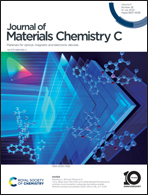Edible polysaccharide-based ultraflexible organic transistors for nutritive electronics†
Abstract
Degradable ultraflexible organic field-effect transistors (OFETs) offer guidance for the development of implantable nutritive electronics and green eco-friendly electronics. Nevertheless, most dielectric materials of OFETs are commonly synthetic, non-decomposable, and even toxic. Hence, it remains a great challenge for devices to simultaneously be ultraflexible, degradable, edible, and nutritive. Herein, nutritive and degradable ultraflexible OFETs based on a self-supporting natural dextran dielectric have been successfully fabricated. The thickness of our ultraflexible device is only 309 nm, and it can maintain an outstanding field effect performance on various curved surfaces. Even when attached to the uneven wings of a damselfly, not only does it not affect its flight, but also the mobility is as high as 2.1 cm2 V−1 s−1. When our devices complete their corresponding missions, they can be biodegraded in water or soil with almost no toxic substances and adverse environmental effects, reducing the pollution caused by e-waste. This research realizes nutritive and degradable ultraflexible OFETs, accelerating the pace of nutritive electronics in future practical applications.

- This article is part of the themed collection: 2023 Journal of Materials Chemistry C HOT Papers


 Please wait while we load your content...
Please wait while we load your content...